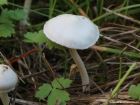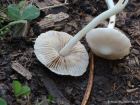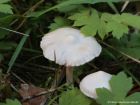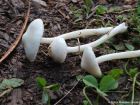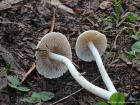Cap white with a yellowish tinge, initially conical, becoming broadly bell-shaped or broadly convex, usually retaining a pointed umbo and streaky radial fibres that in dry weather tend to tear into strips towards the edge of the cap. The cap fades to ochre-brown from the centre as the fruitbody ages. The flesh is white and thin. Gills cream coloured, becoming buff, adnexed and crowded. Stem coloured as the cap but gradually turns clay-brown with age, fairly firm, smooth and silky, sometimes slightly fibrillose towards the base and lacks a ring. Spore print dull brown.
Microscopic Features: The spores have a smooth, elliptical morphology, ranging in size from 7.5-10μm x 4.5-5.5μm.
Note: There are two common varieties of this species: the White Fibrecap, Inocybe geophylla and the Lilac Fibrecap, Inocybe geophylla var. lilacina.
Inocybe geophylla on the First Nature Web site.
Inocybe geophylla on the MushroomExpert.Com Web site.
Many mushrooms are poisonous, and some can be lethally toxic. Distinguishing between edible and poisonous mushrooms can be very challenging. Therefore, we strongly advise against consuming wild mushrooms. This website does not contain any information about the edibility or toxicity of mushrooms.
Although efforts have been made to ensure accuracy on this website, the information may contain errors and omissions. Therefore, all content provided is for educational and informational purposes only and should not be relied upon or used as a basis for consuming any plants or mushrooms.
External links are provided for reference only. We do not endorse or take responsibility for the content, advice, or products found on these sites or in any advertisements shown on this website.
